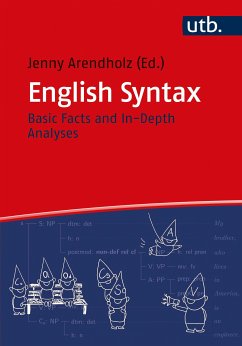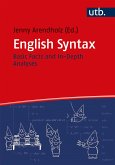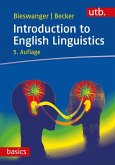English Syntax (eBook, PDF)
Basic Facts and In-Depth Analyses
Redaktion: Arendholz, Jenny


Alle Infos zum eBook verschenken

English Syntax (eBook, PDF)
Basic Facts and In-Depth Analyses
Redaktion: Arendholz, Jenny
- Format: PDF
- Merkliste
- Auf die Merkliste
- Bewerten Bewerten
- Teilen
- Produkt teilen
- Produkterinnerung
- Produkterinnerung

Hier können Sie sich einloggen

Bitte loggen Sie sich zunächst in Ihr Kundenkonto ein oder registrieren Sie sich bei bücher.de, um das eBook-Abo tolino select nutzen zu können.
This collection of pivotal issues about syntactic analysis bridges the gap between two extremes: Quirk et al.'s classic, yet voluminous standard grammar The Comprehensive Grammar of the English Language (CGEL, 1985) and slim booklets with sample solutions. Written for students and teachers alike, this textbook introduces basic concepts, deepens preexisting knowledge, prepares students for various exam contexts and provides hands-on teaching material. Each chapter provides theoretical explanations, which are immediately illustrated by numerous complete sample analyses of sentences taken both…mehr
- Geräte: PC
- ohne Kopierschutz
- eBook Hilfe
- Größe: 12.85MB
![English Syntax (eBook, ePUB) English Syntax (eBook, ePUB)]() English Syntax (eBook, ePUB)28,99 €
English Syntax (eBook, ePUB)28,99 €![Die französische Grammatik (eBook, PDF) Die französische Grammatik (eBook, PDF)]() Uwe DethloffDie französische Grammatik (eBook, PDF)64,99 €
Uwe DethloffDie französische Grammatik (eBook, PDF)64,99 €![Anglo-American Cultural Studies (eBook, PDF) Anglo-American Cultural Studies (eBook, PDF)]() Jody SkinnerAnglo-American Cultural Studies (eBook, PDF)37,99 €
Jody SkinnerAnglo-American Cultural Studies (eBook, PDF)37,99 €![A Student's Advanced Grammar of English (SAGE) (eBook, PDF) A Student's Advanced Grammar of English (SAGE) (eBook, PDF)]() Peter FennA Student's Advanced Grammar of English (SAGE) (eBook, PDF)43,99 €
Peter FennA Student's Advanced Grammar of English (SAGE) (eBook, PDF)43,99 €![Teaching English Literature (eBook, PDF) Teaching English Literature (eBook, PDF)]() Engelbert ThalerTeaching English Literature (eBook, PDF)19,99 €
Engelbert ThalerTeaching English Literature (eBook, PDF)19,99 €![Academic Skills (eBook, PDF) Academic Skills (eBook, PDF)]() Simone BrodersAcademic Skills (eBook, PDF)19,99 €
Simone BrodersAcademic Skills (eBook, PDF)19,99 €![Introduction to English Linguistics (eBook, PDF) Introduction to English Linguistics (eBook, PDF)]() Markus BieswangerIntroduction to English Linguistics (eBook, PDF)22,99 €
Markus BieswangerIntroduction to English Linguistics (eBook, PDF)22,99 €-
-
-
Dieser Download kann aus rechtlichen Gründen nur mit Rechnungsadresse in A, B, BG, CY, CZ, D, DK, EW, E, FIN, F, GR, HR, H, IRL, I, LT, L, LR, M, NL, PL, P, R, S, SLO, SK ausgeliefert werden.
- Produktdetails
- Verlag: UTB GmbH
- Seitenzahl: 250
- Erscheinungstermin: 14. Februar 2022
- Englisch
- ISBN-13: 9783838556550
- Artikelnr.: 71187366
- Verlag: UTB GmbH
- Seitenzahl: 250
- Erscheinungstermin: 14. Februar 2022
- Englisch
- ISBN-13: 9783838556550
- Artikelnr.: 71187366
- Herstellerkennzeichnung Die Herstellerinformationen sind derzeit nicht verfügbar.







